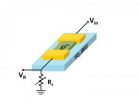(Press-News.org) The Continuous Electron Beam Accelerator Facility (CEBAF) at the U.S. Department of Energy's Thomas Jefferson National Accelerator Facility has achieved the final two accelerator commissioning milestones needed for approval to start experimental operations following its first major upgrade.
In the early hours of May 7, the machine delivered its highest-energy beams ever, 10.5 billion electron-volts (10.5 GeV) through the entire accelerator and up to the start of the beamline for its newest experimental complex, Hall D. Then, in the last minutes of the day on May 7, the machine delivered beam, for the first time, into Hall D.
In addressing staff, Jefferson Lab Director Hugh Montgomery praised the efforts of the many Jefferson Lab staff members who made the accomplishment a reality, "It's really appreciated the way you have worked together and, in particular, the safe way in which you have pulled this off," he said.
The CEBAF accelerator is based on superconducting radiofrequency (SRF) technology and produces a stream of charged electrons that scientists use to probe the nucleus of the atom. CEBAF was the first large-scale application of SRF technology in the U.S., and it is the world's most advanced particle accelerator for investigating the quark structure of the atom's nucleus. CEBAF was originally designed to operate at 4 GeV, and it reached 6 GeV, or 6 billion electron volts in its original configuration.
The 12 GeV Upgrade is a $338 million project to double CEBAF's maximum operational energy and includes the construction of the fourth experimental hall, as well as upgrades to equipment in the existing halls.
On May 7, 10.5 GeV beam was delivered to the Hall D Tagger Facility, which converts CEBAF's electron beam into photons that will be used for experiments in Hall D. To deliver the beam to the Tagger Facility, operators steered it through a newly installed beamline that rises 5 meters, more than 16 feet, as it approaches the Tagger Facility.
"With this accomplished, the beamline elements from the photocathode that generates the electrons through 5.5 passes of the CEBAF racetrack and the new Hall D electron beamline have gloriously transported beam!" said Arne Freyberger, Accelerator Operations manager. "This is not luck. This is a direct reflection of the quality of the staff."
Leigh Harwood, 12 GeV Upgrade project lead for Accelerator, concurred, "The 12 GeV Upgrade project team thanks you for your dedication and the hard work that got us to this moment."
In addition to setting a new energy record for beam in CEBAF, these significant accomplishments complete two of the major 12 GeV Project milestones necessary for Jefferson Lab to be granted the next DOE approval step, Critical Decision-4A (Accelerator Project Completion and Start of Operations).
These two accomplishments build on others. On Feb. 5, accelerator operators sent streams of electrons around the CEBAF accelerator once and achieved full upgrade-energy acceleration of 2.2 GeV in one pass. Then they ran the accelerator at this specification for the next eight hours, achieving 50 percent availability on their first run of the machine at design specifications. On April 1, the CEBAF accelerator delivered electron beams into a target in an experimental hall, recording the first data of the 12 GeV era. The machine sent electrons around the racetrack three times (known as "3-pass" beam), resulting in 6.11 GeV electrons at 2 nanoAmps average current for more than an hour. On May 3, the first beam, with energy of 6.18 GeV, was delivered to the front section of the beamline to Hall D, thus demonstrating that all 5.5 passes of the accelerator were functional and there were no obstructions in the way of the beam. With 5.5 passes functional, CEBAF energy was scaled to 10.5 GeV to achieve these last two milestones.
DOE approval of Critical Decision-4A will permit accelerator operators to continue commissioning the accelerator in order to achieve full 12 GeV energy and to send electron beams to Jefferson Lab's experimental halls for commissioning and the start of experiments.
INFORMATION:
Jefferson Science Associates, LLC, a joint venture of the Southeastern Universities Research Association, Inc. and PAE Applied Technologies, manages and operates the Thomas Jefferson National Accelerator Facility, or Jefferson Lab, for the U.S. Department of Energy's Office of Science.
DOE's Office of Science is the single largest supporter of basic research in the physical sciences in the United States, and is working to address some of the most pressing challenges of our time. For more information, visit science.energy.gov.
CEBAF beam goes over the hump: Highest-energy beam ever delivered at Jefferson Lab
2014-05-14
ELSE PRESS RELEASES FROM THIS DATE:
Who should be saved? Study gets diverse MD community views on healthcare disaster planning
2014-05-14
BALTIMORE—In the event of a flu pandemic, who should have priority access to life-saving ventilators, and who should make that determination? Few disaster preparedness plans have taken community values regarding allocation into account, but a new study is aiming to change that through public engagement with Maryland residents.
"In the event of a healthcare crisis, understanding the community perspective and having citizen buy-in will be critical to avoid compounding the initial disaster with further social upheaval," says principal investigator Elizabeth L. Daugherty ...
Strongly interacting electrons in wacky oxide synchronize to work like the brain
2014-05-14
Current computing is based on binary logic -- zeroes and ones -- also called Boolean computing, but a new type of computing architecture stores information in the frequencies and phases of periodic signals and could work more like the human brain using a fraction of the energy necessary for today's computers, according to a team of engineers.
Vanadium dioxide is called a "wacky oxide" because it transitions from a conducting metal to an insulating semiconductor and vice versa with the addition of a small amount of heat or electrical current. A device created by electrical ...
Research shows hope for normal heart function in children with fatal heart disease
2014-05-14
DETROIT, Mich., - After two decades of arduous research, a National Institutes of Health (NIH)-funded investigator at the Children's Hospital of Michigan (CHM) at the Detroit Medical Center (DMC) and the Wayne State University School of Medicine has published a new study showing that many children with an often fatal type of heart disease can recover "normal size and function" of damaged sections of their hearts.
The finding by Children's Hospital of Michigan's Pediatrician-in-Chief and Wayne State University Chair of Pediatrics Steven E. Lipshultz, M.D., F.A.A.P., F.A.H.A., ...
Study finds free fitness center-based exercise referral program not well utilized
2014-05-14
Eliminating financial barriers to a fitness center as well as providing physician support, a pleasant environment and trained fitness staff did not result in widespread membership activation or consistent attendance among low income, multi-ethnic women with chronic disease risk factors or diagnoses according to a new study from Boston University School of Medicine. The findings, published in Journal of Community Health, is believed to be the first study of its kind to examine patient characteristics associated with utilization of community health center- based exercise ...
Study finds outcome data in clinical trials reported inadequately, inconsistently
2014-05-14
Philadelphia, May 14, 2014 – There is increasing public pressure to report the results of all clinical trials to eliminate publication bias and improve public access. However, investigators using the World Health Organization's International Clinical Trials Registry Platform (ICTRP) to build a database of clinical trials involving chronic pain have encountered several challenges. They describe the perils and pitfalls of using the ICTRP and propose alternative strategies to improve clinical trials reporting. This important and insightful study is published in the August ...
Enzyme helps stem cells improve recovery from limb injuries
2014-05-14
AUGUSTA, Ga. – While it seems like restoring blood flow to an injured leg would be a good thing, it can actually cause additional damage that hinders recovery, researchers say.
Ischemia reperfusion injury affects nearly two million Americans annually with a wide variety of scenarios that temporarily impede blood flow – from traumatic limb injuries, to heart attacks, to donor organs, said Dr. Babak Baban, immunologist at the Medical College of Georgia and College of Dental Medicine at Georgia Regents University.
Restoring blood flow actually heightens inflammation ...
By itself, abundant shale gas unlikely to alter climate projections
2014-05-14
DURHAM, N.C. -- While natural gas can reduce greenhouse emissions when it is substituted for higher-emission energy sources, abundant shale gas is not likely to substantially alter total emissions without policies targeted at greenhouse gas reduction, a pair of Duke researchers find.
If natural gas is abundant and less expensive, it will encourage greater natural gas consumption and less of fuels such as coal, renewables and nuclear power. The net effect on the climate will depend on whether the greenhouse emissions from natural gas -- including carbon dioxide and methane ...
New smart coating could make oil-spill cleanup faster and more efficient
2014-05-14
In the wake of recent off-shore oil spills, and with the growing popularity of "fracking" — in which water is used to release oil and gas from shale — there's a need for easy, quick ways to separate oil and water. Now, scientists have developed coatings that can do just that. Their report on the materials, which also could stop surfaces from getting foggy and dirty, appears in ACS Applied Materials & Interfaces.
J.P.S. Badyal and colleagues point out that oil-spill cleanup crews often use absorbents, like clays, straw and wool to sop up oil, but these materials aren't ...
Advance brings 'hyperbolic metamaterials' closer to reality
2014-05-14
WEST LAFAYETTE, Ind. - Researchers have taken a step toward practical applications for "hyperbolic metamaterials," ultra-thin crystalline films that could bring optical advances including powerful microscopes, quantum computers and high-performance solar cells.
New developments are reminiscent of advances that ushered in silicon chip technology, said Alexandra Boltasseva, a Purdue University associate professor of electrical and computer engineering.
Optical metamaterials harness clouds of electrons called surface plasmons to manipulate and control light. However, some ...
New efforts aim to shore up forensic science -- but will they work?
2014-05-14
Five years ago, a report on the state of forensic science by the National Academy of Sciences decried the lack of sound science in the analysis of evidence in criminal cases across the country. It spurred a flurry of outrage and promises, but no immediate action. Now, renewed efforts are underway, according to an article in Chemical & Engineering News, the weekly news magazine of the American Chemical Society.
C&EN editors Andrea Widener and Carmen Drahl note that the 2009 report served as a critical wake-up call to the public, defense attorneys and policymakers. Even ...



